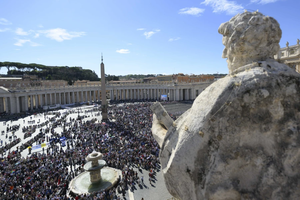How the Restless Heart of St. Augustine Found Rest
The constant intercession of St. Monica and a rich friendship with St. Ambrose prepared Augustine’s heart to rest in God.

St. Augustine is among Christianity’s most influential converts, second only to St. Paul. Augustine’s many writings, especially his spiritual autobiography, Confessions, document his metamorphosis from a young man mired in hedonism and pagan heresies to a baptized Christian.
Canonized shortly after his death, Augustine was named a Doctor of the Church in the 13th century, and remains one of the most towering figures in Christian theology. His impact, which has not lessened with the passing centuries, is due largely to his prolific writing. During his lifetime he wrote dozens of books and hundreds of letters and sermons, participated in Church councils as the Bishop of Hippo, and worked alongside other Church Fathers to correct heresies and defend the Bride of Christ. Because of the vast written legacy he left behind, we can form a clear picture not only of Augustine’s brilliant mind and theological acuity, but of his own journey to fall in love with Christ.
An intellectual giant, Augustine had an insatiable desire to seek truth. But a close reading of his works shows that while the coherence of the Church’s teaching appealed greatly to his keen mind, it was personal encounters with devout, loving Christians that first opened Augustine’s eyes to his future faith.
The first individual, naturally, was his mother, St. Monica. A pious Christian woman, Monica ensured her son received a thorough catechesis as a child. When she watched, heartbroken, as he abandoned the virtues with which he had been raised in order to seek worldly achievements, and even taking a series of mistresses, she poured herself out in prayer and fasting for his soul.
When she was tempted to use coercion to bring her son back to the fold, a spiritual director held her in check, assuring her that God heard all of her prayers and not one would be wasted. Heeding this wise counsel, Monica continued praying for her son, refusing to indulge or endorse his sinful life, while continuing to love him and show him her own faithful example.
The second notable relationship in Augustine’s conversion was his friendship with the great St. Ambrose, Bishop of Milan. Ambrose, the aforementioned spiritual director of Augustine’s mother, was celebrated throughout early Christendom for his prowess as an orator. But it was not his rhetorical skills that won over Augustine’s heart. As the saint himself writes:
And to Milan I came, to Ambrose the bishop, famed through the whole world as one of the best of men, thy devoted servant. His eloquent discourse in those times abundantly provided thy people with the flour of thy wheat, the gladness of thy oil, and the sober intoxication of thy wine. To him I was led by thee without my knowledge, that by him I might be led to thee in full knowledge. That man of God received me as a father would, and welcomed my coming as a good bishop should. And I began to love him, of course, not at the first as a teacher of the truth, for I had entirely despaired of finding that in thy Church — but as a friendly man.
Ambrose did not corner Augustine. He did not look at him, a man quickly becoming disillusioned with the errors into which he’d fallen, and think “Ah, let me go about converting him.” He instead befriended the lost sheep, becoming almost like a father to Augustine, whose own father had recently died. Ambrose knew he spoke the truth, but he did not rely on his own “eloquent discourse” to sway Augustine. Instead, he trusted God to work through him, and simply showed Augustine Christ’s love, answering his questions without guile or antagonism.
Finally, after many years, the constant intercession of his mother and the rich friendship with Ambrose had prepared Augustine’s heart so that he finally could receive the gift of faith. In a poignant moment, he writes of coming upon Holy Scripture, which fell open to a letter from St. Paul, urging the early Christians to cease their sinful ways and to live as those who have been transformed by the risen Christ. The last vestiges of disbelief fell from Augustine’s eyes, and he joined the Church shortly thereafter. He was baptized, along with his illegitimate son, by Ambrose himself on Easter Sunday.
Augustine’s conversion reveals profound implications for how we too should hope to live if we desire to bring others to Christ. We should not fear to speak the truth. Nor should we fall prey to the pressure of the world and validate actions we know are sinful. To do so would be singularly unloving.
But like Monica and Ambrose, we must place our intentions in God’s hands — cultivating personal relationships with others, founded on trust and infused with a love informed by truth. Had Augustine found Ambrose to be cold or hostile, he likely would not have bothered to hear the good bishop’s wisdom. Similarly, if Monica had resorted to coercion or guilt to trap her son, she would have lost the graces gained through her constant prayer.
In our day, when the social media soundbite is so much easier to share, or the witty opinion piece simpler to write, we are called to remember that our efforts will only succeed if they are surrendered to God, sacrificing our vanity to allow us to fully unite our will to his.
St. Augustine, pray for us!
- Keywords:
- st. augustine
- st. monica
- st. ambrose
- church fathers

















